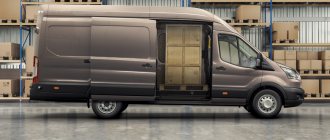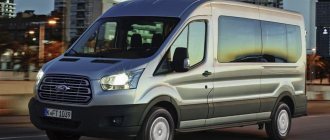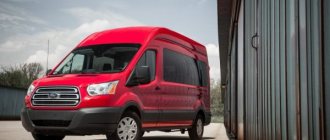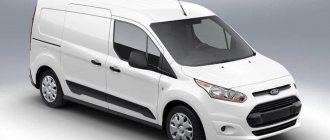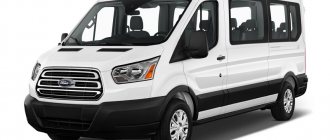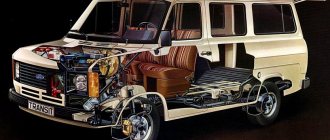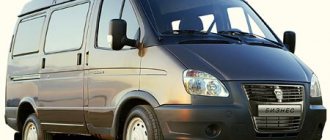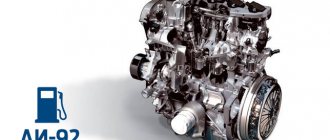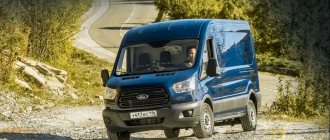Car history
The idea of creating this model came to the minds of the designers of the Ford automaker when they decided to strengthen their position in the European automobile market in the 60s.
The first cargo vans designed were called Redcap, but this was abandoned in favor of Transit, which was more understandable to most Europeans. Back then, in the 60s, Ford Transit cars looked spartan. They attracted buyers with their reliability and practicality.
Due to the ability of the platform to adapt to different modifications, Ford Transit has found application in various public spheres. It has been converted into police and fire trucks, medical carriages and school buses.
Growing demand in the cargo segment of the market gave impetus to the creation of three variants of Ford Transit models with different load capacities of 610 kg, 865 kg and 1120 kg.
Every few years, the external and internal appearance of the car was updated:
- 1971 - a new radiator grille, which gave the Ford Transit the appearance of a passenger car, a new 5.0-liter V-engine;
- 1972 - a diesel version of the engine appeared;
- 1975 – modernization of appearance (black radiator grille, bumpers, mirrors);
- 1978 - models with an extended body appeared, running on diesel and gasoline;
- 1984 - a 2.5 liter DI engine was installed on the cars;
- 1985 – new wide doors, independent suspension from McPherson;
- 1991 – installation of triple seats, 2.5-liter DI diesel engine with turbocharging, power increase to 100 hp. With.;
- 2000 - updated model in two versions - rear-wheel drive and front-wheel drive;
- 2002 - the new Ford Transit with a carrying capacity of 4.25 tons was introduced;
- 2006 – The gear shift lever was moved to the dashboard.
Over the course of numerous restylings, the Ford Transit has evolved from an ordinary practical car into one of the most recognizable and best-selling models on the market.
Characteristics of Ford Transit / Ford Transit
In the early 60s, Ford specialists set themselves the task of creating a comfortable, versatile vehicle for the European market. Hence, there are many different modifications of the basic Transit: from a traditional truck with a rear drive axle to front-wheel drive delivery vans with a lowered body floor.
The original name of the car was “Redcap”, and only in 1965, just before the launch of production, preference was given to the name Transit. Arguing this choice by the internationality of this name, which will be understandable to customers all over the world.
Since then, Transit vans have been used in various fields of human activity: they served as police and fire vehicles, acted as ambulances and school buses, and, of course, transported a wide variety of cargo. Special tanks and dump trucks were made on the Transit basis. And by order of one of the Arab sheikhs, Transit was turned into a mobile bedroom with a luxurious bed.
The first generation of these cars appeared in 1965. And under the hood they had a V-shaped four-cylinder gasoline engine.
In 1978, production of the second, highly modernized generation began. New engines appeared, the appearance became more strict (rectangular headlights, plastic radiator grille).
The third generation Transit entered production in 1986. It was produced in the form of several models, which differed in different base lengths and maximum loads.
The main driving force was a 2.5-liter diesel engine with direct fuel injection.
In 1989, an 80 hp diesel engine appeared. as well as a 2.0 liter diesel with an adjustable catalyst.
In 1991, the model was modernized.
In 1994 there was a slight restyling: an oval cladding replaced a radiator grille made of horizontal bars.
A new generation appears in 2000. The Transit family is growing even more numerous: vans, buses and utility vehicles with two wheelbase lengths (2835 and 3570 mm), flat, raised (medium) or high roofs.
The steering wheel is set almost horizontally, and the back of the driver's seat is strictly vertical. A wide range of adjustments allows you to find the optimal position for a person of any configuration. The high seating position provides the driver with excellent visibility; the rear view mirrors also do their job well. They are divided in two horizontally: the lower part of the mirror shows the area near the rear wheel, and the upper part shows the side of the body and the cars next to it.
The salon is quite spacious. Note that the passenger seats for both the eight-, nine-, and twelve-seat versions are exactly the same. The fruits of unification are visible. At the customer's request, the Transit can be either front- or rear-wheel drive. Moreover, these versions have minimal differences from each other. The secret is simple: the body itself is universal for both versions, as well as the brake and hydraulic systems. And the engine with attachments and suspension is mounted on a special subframe. Thus, by replacing the entire subframe, you can very quickly make a front-wheel drive Ford Transit rear-wheel drive.
Based on the large commercial model Transit, Ford has created another “commercial” - Transit Connect. It has an original appearance and is slightly smaller than its ancestor, although it borrowed many of its components and assemblies. Ford Transit Connect is available in several modifications built on a common platform, which differ in overall dimensions and interior equipment. The maximum carrying capacity of the vehicle in one of the modifications is 900 kilograms, and the van itself is equipped with one of two modern turbodiesels. This model received the title of "Van of the Year 2003".
Literally immediately after the debut of the new generation in 2000, Ford presented an unusual Transit, prepared by the Ford Racing sports department with the WRC prefix. The power of the serial 2.4-liter turbodiesel was increased to 165 hp, thanks to which the Transit WRC could accelerate from zero to “hundreds” in just 7.9 seconds, and the top speed reached over 200 km/h. The van had a powerful and reliable safety cage, carbon fiber sports seats with five-point seat belts. The front discs are ventilated, with a diameter of 400 mm. There were two types of tires available for the Transit WRC: 18 and 20-inch wheels.
By 2001, the range of engines for the Transit included: 2.0-liter DuraTorq TD turbodiesels, which developed power of 55, 63 and 74 hp. Rear-wheel drive versions were equipped with 2.4-liter turbodiesels, which, depending on the degree of boost, produced 90 or 125 hp. For fans of fast driving, a 145-horsepower gasoline unit was reserved in the engine range.
However, in 2002, Ford added a 125-horsepower turbodiesel with direct fuel injection, DuraTorq TDCi, to the engine lineup. The development of this power unit cost Ford 500 million. USD
In 2001, Ford released the DuraShift EST. There is no gearshift lever or clutch pedal in the interior of this car. Their functions are performed by three keys located on the front panel just above the radio: “N” (neutral), “D” (drive) and “R” (reverse). The selected gear is displayed on a small LCD display. Several control modes indicate the advancement of the automatic transmission: “economy”, “under load” and “winter mode”. But the most interesting thing is that the downshift and upshift buttons are located directly on the steering wheel spokes.
2002 saw the debut of the Transit Jumbo and a 17-seater minibus version. The Jumbo is the heaviest version of the Transit, with a gross all-metal van weight of 4.25 tonnes. The parameters of the cargo compartment are 4.107 meters in length and up to 1.885 meters in height. The width of the side sliding door allows loading/unloading of Euro pallets. The useful volume of the cargo compartment reaches 14.25 m³. Transit Jumbo can lift up to 2.12 tons of cargo on board.
The history of Ford Transit continues; the creators do not stand still, but follow the latest trends in the automotive market. So, wanting to please the most demanding customers, in the summer of 2003 Transit was equipped with additional options. For example, the Security option package includes: an alarm system, heated electric mirrors, an unglazed partition between the driver's cabin and the cargo compartment, and a parking sensor system.
The Courier Safety Package gives delivery vans the option of an integrated step on the rear bumper, making loading/unloading easier and safer. And finally, the most complete package of Executive options includes: heated electric mirrors, central locking, electric windows, fog lights, CD radio, tinted windows and a rapid windshield heating system.
Confirmation of the high level of the brand is the appearance in 2003 of the Transit Connect model with a bi-fuel engine. This power unit is based on a 1.8-liter Duratec. Gas equipment is mounted directly at the factory. The gas tank holds 59 liters of fuel and is located under the bottom of the cargo compartment in the space for the spare tire. As a result, the spare wheel had to be moved inside the cargo compartment to the left rear arch. The use of gas fuel significantly reduces emissions of harmful substances into the atmosphere.
At the end of 2003, the Connect X-Press was created by a team of Ford engineers. Compared to the regular Transit, the car is 70 mm lower and borrows some suspension and chassis elements from the Focus. Got 18-inch alloy wheels. To personalize this model and make it stand out from the crowd of different vans, X-Press is written on the side of the vehicle in three colors. It can accelerate to 100 km/h in less than 7 seconds and has a top speed of 210 km/h.
From the Focus RS, the minivan received a 215-horsepower 2-liter Duratec RS turbo engine, a 5-speed transmission, Brembo brakes with ventilated discs of 325 mm in front and solid 280 mm in the rear. It has McPherson suspension at the front, and the classic Transit suspension at the rear. The interior, of course, remains in many ways the typical Transit Connect interior, but now there are sports-style leather seats in Alcantara in black and white and a unique steering wheel specially made for the X-Press, and on the center console there is a starter button familiar to RS owners.
Ford Transit can be called a cult model, and statistics confirm this: four million copies over 35 years of existence.
Exterior of Transit 2014
It fully justifies its international name. Similar to cars produced in America, but with some changes in configuration.
It has several configuration options to choose from:
- cargo compartment 2 m long, volume 15500 l;
- cargo compartment 1.8 m long, volume 10,500 l;
- cargo compartment 1.4 m long, volume 7200 l.
The opening angle of the rear cargo doors is 270 degrees.
Volumetric front bumper and large radiator grille.
Ford minibus transmission
Manual transmission or automatic transmission Transit requires regular maintenance, during which the oil level and the tightness of components are checked. If extraneous noise appears in the transmission or complicated shifting, comprehensive diagnostics are carried out. Most often, the causes of such unpleasant phenomena are worn bearings, synchronizers, gears, increased play on the shaft, and a drop in oil level. Oil leaks can be caused by sagging gaskets, defective seals, poor connection between the box and the crankcase, and poor fixation of the crankcase cover. The cover is located on the left on N series gearboxes, MT75, on the right on G series gearboxes.
When overhauling a gearbox, a set of seals, gaskets, bearings, synchronizers, gears, shift elements, and a locking device are replaced.
To avoid serious damage, you should follow three simple rules:
- Change your oil in a timely manner.
- Avoid overloads that negatively affect the life of the unit.
- Carry out preventive treatment of the transmission with RVS-Master Tr or Atr. This will allow you to restore the geometry of the gears and working surfaces due to the cermet layer. The amount of noise and vibration will gradually decrease, gear shifting will become easy and clear, and wear on the contact elements of the gear wheels will be eliminated.
Interior
The car has undergone many changes over the many years of its existence and now pleases owners with an updated interior. He has:
- instrument panel with LED backlight;
- instrument panel;
- steering wheel with multifunction controls;
- navigation system with 6.5 inch screen;
- MyFord SYNC voice control;
- possibility of adjusting the driver's seat;
- capacity up to 15 people;
- large storage space;
- the backs of the passenger seats recline forward to accommodate luggage;
- the back of the middle seat transforms into a convenient table;
- heated windshield function;
- rear view cameras;
- electrical equipment has powerful current consumers and is reliably protected. Ford Transit fuses are located both inside the passenger compartment and under the hood.
Specifications
The 2014 Ford Transit car belongs to the 6th, 7th generation and is available in different body types and has excellent technical characteristics.
Power unit
The wide range of Ford Transit models allows customers to choose the type of engine that suits them best.
The Ford Transit engine is available in the following options:
- 2.2-liter Duratorq TDCi l4 diesel engine is the most common option in Russia;
- diesel engine Duratorq TDCi l4 with a volume of 2.4 liters - almost never found on Russian roads;
- hybrid V6 Prep Kit with a volume of 3.7 liters – can run on both natural gas and gasoline;
- 3.2-liter Power Stroke turbodiesel.
Ford Transit engines are lightweight and highly reliable.
Transmission
Every Ford Transit vehicle operates on a 5 or 6-speed manual transmission. Gear shifting occurs smoothly without much effort. They all have synchronizers. The last switching stage acts as a step-up.
The operating principle of the gearbox is close to that of passenger cars; speeds are switched in the correct mode.
Suspension
The Ford Transit car has different suspension options. Only two of them are common in Russia:
- independent front suspension MacPherson system with shock absorber and stabilizer;
- rear dependent suspension with hydraulic shock absorbers.
Steering
The steering device is of a rack and pinion type with a built-in hydraulic booster. The steering rods do not differ in length due to the structure of the rack - the hinges are located at its ends cantilevered to the supports. This limits the steering angle and reduces the number of steering revolutions.
Due to its size, the car has tight steering on sharp turns.
Brake system
Ford Transit has ventilated disc brakes on all wheels. The hydraulic type of brake system includes two circuits and a vacuum booster. The contours are divided diagonally.
The car has an ABS system as standard. Has an auxiliary braking device that connects each circuit to a mechanical drive.
Safety
Ford Transit is considered one of the safest M class cars. The following are responsible for the safety of the driver, passengers, and cargo:
- airbags;
- three-point belts that hold the driver and passengers while driving;
- possibility of attaching child seats with the Isofix system;
- the traction control controls the braking system, prevents slipping of the drive wheels, and prevents the vehicle from tipping over when turning on a slippery road;
- emergency braking system;
- you can set a course using the Lane Keeping Alert system, which keeps the car within one lane;
- reinforced body in the front and sides.
Model history and purpose
Ford Transit is one of the oldest cars in the world. The first vehicle of this family appeared back in 1953 and was called FK 1000. In 1961, the van was renamed Ford Taunus Transit. There was no talk of export at that time. However, the production of cars gradually expanded, and the model itself experienced noticeable changes. The debut car called Ford Transit was presented in 1965. The van was produced in England, Belgium, Turkey, and then in China. The model was noticeably different from standard commercial vehicles in Europe. The wide track compared to its competitors gave many advantages, so the Ford Transit soon became very popular. In 1978, the premiere of the second generation of the model took place, which at that time was used not only in the commercial segment, but also in special services (Ambulance, Ministry of Emergency Situations, police).
4th generation
In 1986, production of the fourth generation of the model began. The car featured a “single-box” body design. The developers decided to abandon the strongly protruding hood (the windshield and hood were now located at the same angle). In 1992, the Ford Transit underwent a major restyling. The underbody has been completely redesigned and the distance between the axles has been increased. Changes also affected the design of bridges, where cylindrical bearings began to be used. The third Ford Transit was distinguished by its high maneuverability and speed, which attracted the interest of many customers. Single copies of this generation are still successfully used on the Russian market.
5th generation
In 1994, the Ford Transit underwent a restyling procedure, receiving a new dashboard and front end (the radiator grille made of horizontal bars was replaced by an oval cladding). A 2-liter engine from the Ford Scorpio has appeared in the line of power units. The third generation was sold in Europe until 2000.
6th generation
The sixth Ford Transit received a completely new appearance, borrowing features of the company's corporate identity used in the Focus model. The new modification was offered with front- and rear-wheel drive (V185 and V184). Versions with the Puma diesel engine installed in the Jaguar X-Type and Ford Mondeo were also available. An automatic transmission was offered for top-end variations. At the same time, the manufacturer took care of the driver, providing the seats and steering wheel with many adjustments, allowing you to choose the optimal position. Due to the high landing, good visibility was achieved. The interior of the Ford Transit IV became larger and was designed for 8 or 12 passengers. Based on the standard version, the automaker has also prepared a smaller version – Transit Connect. The model was made slightly smaller than the “progenitor”, adding to this a modified appearance. The maximum load capacity of the model is 900 kg.
Read also: What is under the hood of the Kia Spectra
7th generation
In 2006, the model was restyled as a new generation. The Ford Transit received new lights, interior and a redesigned front end. The gearbox has been completely changed. Diesel units received the HPCR system, and gasoline engines were borrowed from the Ford Ranger. In 2007, the Ford Transit was named Van of the Year. A little later, the line of power units was updated again. It began to include exclusively engines that comply with Euro 4. It is this variation that remains the most popular among Russians.
8th generation
In 2013, sales of the Ford Transit Custom and Ford Tourneo Custom models began in Russia. The first has become one of the best in its class due to its incredible safety and performance indicators. These versions are produced at the plant in Elabuga (Russia).
Ford Transit is used to solve a wide range of problems. The onboard modification is suitable for side and rear loading/unloading on Euro pallets. The reinforced platform allows you to transport large loads without fear for the safety of the vehicle. An easily removable awning will help protect against external factors. Ford Transit models are ideal for transport services. Passenger options are actively used in taxis on suburban and intercity routes, providing maximum comfort and safety of transportation.
Ford Transit can be called a truly iconic model, which is confirmed by the huge demand for this car.
Price and equipment
The Russian car market is not very diverse for Ford car lovers. Without any problems, you can only buy a diesel model with a 2.2-liter engine. The equipment is not rich, but it can be expanded for an additional cost.
A car with basic equipment will cost from 2,000,000 rubles in car dealerships.
Used Ford Transit has different prices in advertisements. Older models from the 80s are sold from 100,000 rubles. Cars in good condition before 2010 are valued at 300,000 rubles, later ones have a price of 500,000 rubles.
Owner reviews
Ford Transit is popular among car enthusiasts. Among the qualities noted are reliability, engine power, high-strength front suspension, which performs well on rough roads.
The car does not require special care in operation. Spare parts for repairing Ford Transit are always available and inexpensive. Replacing failed parts is easy.
Valery, 32 years old, Moscow:
“I appreciate this car for its maneuverability and reliability on dangerous sections of the road.”
Kirill, 40 years old, Tula:
“The most dissatisfaction is caused by the rapid wear and tear of the body, which rusts due to snow and reagents on the road. I've already tried to restore it. But I can’t do anything, because our roads leave much to be desired.”
Car owners note that most often they have to change Ford Transit radiators, as well as oil and air filters.
Ford minibus engine repair
For Ford diesel engines up to 2.4 liters, the most dangerous malfunction is a jump in the timing chain. Because of this, the cylinder head is destroyed. The use of a non-original fuel filter and contamination of the pressure relief valve lead to sad consequences.
During the overhaul, the crankshaft, piston rings and liners are changed, and the shaft is ground. But the exact list of work depends on the existing breakdowns and the degree of wear of parts. Defects can be judged by characteristic symptoms. For example, if the engine stalls immediately after starting, the fuel system, pre-heating is faulty, or air has entered the diesel fuel. In case of low compression, the engine idle speed fluctuates. The same thing happens when the air filter element is dirty.
[ads2]
Advantages and disadvantages
The pros and cons of the model are shown in the table.
| pros | Minuses |
|
|
Ford Transit photo
You can view the interior and exterior of the car in the photo.
